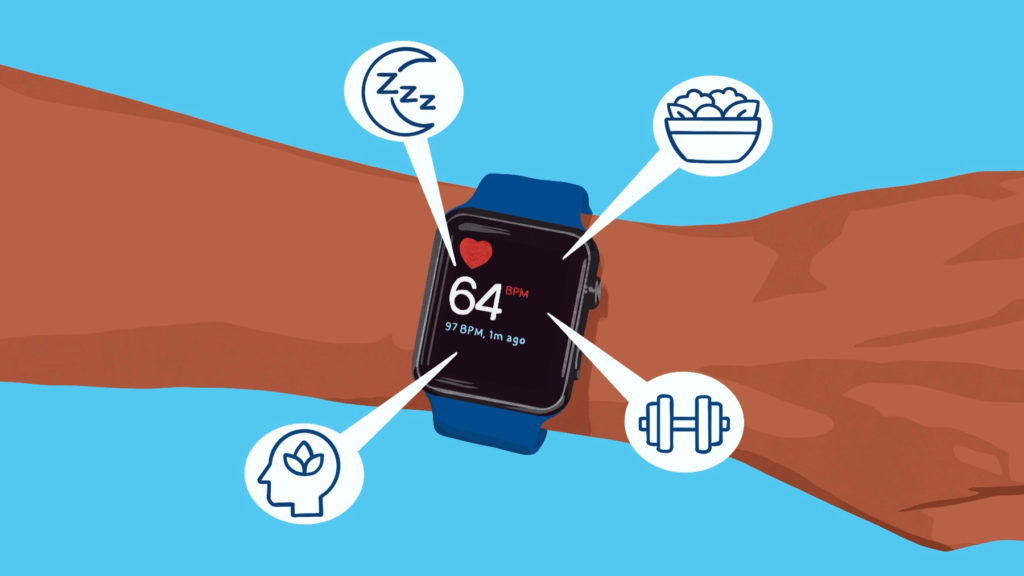Wearable devices are collecting reams of health data. But, we still aren’t sure what to do with it.
Health 2.0
Increasingly dissatisfied with the broken healthcare system, consumers are taking an active role in managing their well-being.
Aided by a growing number of apps, wearables, and at-home diagnostics, a paradigm shift is underway.
- The global fitness tracker market is expected to reach $139B by 2028.
- 39% of US consumers own a smartwatch or fitness tracker; 14% bought their device since the start of the pandemic, per Deloitte.
- The most popular uses include counting steps (59%) and measuring fitness (42%), but detecting stress levels (17%) and COVID symptoms (11%) are gaining.
Among health optimizers, it’s not uncommon to wear multiple devices for quantifying workouts, sleep, and blood glucose. Next up, hardware for measuring hydration, sweat, cortisol, ketones, and other biomarkers is taking shape.
Beyond biohackers, the hope is that technology will usher in a new era of personalized, preventative healthcare, replacing our reactive sick care system once and for all.
But, siloed data and a lack of actionable insight pose challenges for companies and consumers alike.
The Body’s GPS
With each new iteration, fitness trackers are looking more and more like medical devices.
Meanwhile, smart mattresses, bathroom scales, and toilets seamlessly capture and decode health metrics.
We’re moving toward a future where continuous, noninvasive, clinical-grade insights are easily accessible, but for now, we’re just scratching the surface of understanding what’s happening inside our bodies.
Exploring this uncharted territory, former a16z general partner Balaji Srinivasan said:
“We know what’s going on in Bangalore or Budapest, but not in our bodies… we don’t know what’s going on subcutaneously. It’s an amazing blank spot on the map.”
Likening the power of real-time health data to that of GPS, Srinivasan said people don’t have to worry about getting lost anymore — “you never don’t know where you are.” Soon, he remarked, “you will never not know your infection.”
Ecosystems. Pursuing this vision, Big Tech is pushing further into healthcare. Using fitness trackers as Trojan horses for activity data, companies like Apple, Amazon, and Google are creating powerful lock-ins within their respective ecosystems.
In addition to enhancing sensor capabilities in their own hardware, tech giants are aggregating health data from other devices, conducting medical studies, and paving a path to sync with electronic health records (EHR).
Integrations. Another avenue, wearable makers and health apps are joining forces. Improving the user experience by enabling greater interoperability, personalized and actionable recommendations based on real-time biometrics are becoming a reality.
Opening its platform, WHOOP recently announced a new developer kit and export options. Oura has also been busy, linking with Natural Cycles for birth control, Therabody for sleep optimization, and Strava for social fitness.
Meanwhile, Strava CEO Michael Horvath told us the company aspires to be a connected wellness hub, creating an “Athlete HealthKit” by aggregating insights from a wide range of health wearables.
APIs. Building the infrastructure for enhanced interoperability, health-focused APIs are unlocking siloed data.
As TERRA CEO Kyriakos Eleftheriou put it, if developers can easily access health data, there’s no limit to what can be built. But, gaining access can be a challenge.
Tackling this problem, companies like TERRA, Thryve, Vital, and Human API offer an all-in-one digital health integration.
If You Track It…
According to Harvard professor and entrepreneur David Sinclair, improving health starts with tracking it:
“We’re changing the way we treat people in medicine and with wellness. We have to personalize it. And the only way to personalize something is to measure it… It now means we can tailor your food to you, your supplements, your exercise — because everybody responds differently.”
In the not-too-distant future, Sinclair mused, there would be an app capable of assessing nutritional deficiencies in real time that could then recommend a personalized meal. A step further, he added, it might relay the recipe to a restaurant or delivery service for on-demand fulfillment.
Looking ahead: From battery life and affordability to improved interoperability, wearable tech has a ways to go before Sinclair’s vision takes hold. Then, of course, there’s still the question of how it meaningfully improves the cost or quality of healthcare.
But, as innovation continues, the hope is that we’re moving closer toward the personalized, preventative future of well-being.
🤝 Mindbody x ClassPass
Last we spoke to Fritz Lanman, he was leading ClassPass… at a time when COVID shuttered in-person fitness.
Returning to the Fitt Insider Podcast: Fritz discusses ClassPass’s acquisition by Mindbody, his transition to CEO, and his vision for moving the combined booking platform forward.
We also cover: wellness trends that will reshape the industry.
Listen to today’s episode here
🆘 Crisis Mode
It’s official: Physical inactivity is a global crisis.
What’s happening: The World Health Organization (WHO) released its first-ever Global Status Report of Physical Activity, citing some dismal statistics and urging intervention from governments across the globe.
By the numbers:
- 81% of adolescents and 27.5% of adults don’t meet WHO’s recommended levels of physical activity.
- Among high-income nations, 70% of all healthcare costs will soon be spent on treating illnesses resulting from physical inactivity.
- At the current rate, ~500M people will develop heart disease, obesity, diabetes, or other noncommunicable diseases this decade.
Issuing a warning, the report estimates that the health implications of inactivity will cost the world economy upward of $27B annually, totaling $300B between 2020–2030.
Dire straits. Taking action to reverse these troubling trends, the WHO calls on more countries to implement policies that encourage walking, cycling, sport, and other forms of physical activity, adding:
“The benefits are huge, not only for the physical and mental health of individuals, but also for societies, environments, and economies.”
But… inactivity is worsening. For instance, American physical activity levels have yet to improve since the government first started recommending 150 minutes per week in 2008, with only 23.2% currently meeting the minimum.
Punchline: Easier said than done, promoting physical activity will also require addressing widespread inequities that make moving more (and eating well) a challenge for people the world over.
Share this headline
❤️ Apple’s Next Act
Apple is rumored to be targeting health insurance.
What’s happening: Likely partnering with an incumbent, Apple could leverage its ecosystem of data, wearables, and developer tools to enter the $1.1T health insurance industry by 2024.
For context: Apple recently doubled down on becoming the “center of health” for both consumers and doctors.
According to CCS Insights’ chief analyst Ben Wood, that position lends itself to the insurance market, too:
“They’ve got a wealth of personal health data through Apple Watch. If they join some of the dots together they can become a very competitive health insurance player and that potentially is going to have quite an impact on the structure of the healthcare market in the U.S.”
With advanced biometric features on Apple Watch, third-party developer tools, health tracking capabilities, and Fitness+ on every iPhone, Apple has the components to incentivize personal well-being.
Emphasizing preventative wellness, Apple could gamify health insurance. Notably, it already has a foot in the door, providing Apple Watches to members of UnitedHealthcare, Devoted Health, and John Hancock’s Vitality.
Zooming out: Apple isn’t alone in eyeing insurance. After shuttering Haven, its joint venture with JPMorgan and Berkshire Hathaway, as well as its in-house telehealth service, Amazon scooped up One Medical.
Meanwhile, rival retailer Walmart has made inroads by partnering with UnitedHealth, launching a co-branded Medicare Advantage plan while scaling virtual, in-clinic, and medical research capabilities.
Takeaway: Selling more smartwatches and boosting services revenue, Apple’s healthcare ambitions align with business objectives and Tim Cook’s commitment to making health the company’s “greatest contribution to mankind.”
Share this headline
📰 News & Notes
- Whole Foods predicts next buzzy health foods.
- Samsung switches on telehealth for smart TVs.
- Wahoo takes Zwift to court over Hub smart trainer.
- Fitt Jobs: the ultimate resource for careers in health & fitness.
- Canyon Ranch plots wellness resort expansion, launches new app.
- Kevin Durant becomes latest athlete to buy into Major League Pickleball.
- David Beckham sues F45 for missed payments. [Re-read: The Fate of F45]
- Startup Q&A: Run As You Are (RAYA) co-founder Nick Lo on web3 x running.
💰 Money Moves
- HYROX, operator of indoor fitness competitions, raised an undisclosed follow-on investment from Infront Sports.
- International soccer star Lionel Messi launched Play Time Sports-Tech, a holding company investing in sports, media, and tech.
- GOLF+, a VR golfing experience for Oculus Quest, secured $6M in a funding round led by Breyer Capital, with participation from golfers Rory McIlroy and Jordan Spieth, among others.
- TMRW Sports, a tech-enabled golf league backed by Tiger Woods and Rory McIlroy, raised $15M in new funding.
- Limber, a hybrid MSK clinic, closed $11M in an oversubscribed Series A round led by Blue Venture Fund.
- Cofertility, an egg donation and freezing service, landed $5M in a seed round co-led by Initialized Capital and Offline Ventures.
- Abortion telemedicine startup Hey Jane raised $6.1M in a funding round.
- Digital athletic training platform CoachMePlus raised $1M in new funding.
- Digital couples therapy platform HeyRitual raised $2M in a pre-seed round led by GroundUp Ventures.
- Mental healthcare platform Mindful Care raised $7M in a Series B round led by Sopris Capital.
- Olistic, a Spanish neutraceutical company treating hair loss, pulled in €6M ($5.87M) in a funding round led by Iris Ventures.
- Paleo and keto brand Hunter & Gather raised over £892K ($1.02M) in crowdfunding.
- Scout, manufacturer of wild-caught tinned seafood, added $4M in seed funding.
- Nourish Ingredients, an Australian foodtech firm producing lab-grown animal fats, raised $28.6M in a Series A round led by Horizons Ventures.
Today’s newsletter was brought to you by Anthony Vennare, Joe Vennare, and Ryan Deer.






